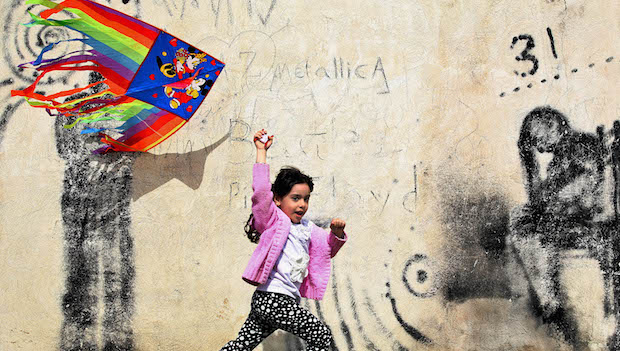
An Iranian girl runs with a kite during the ancient festival of Sizdeh Bedar, an annual public picnic day on the 13th day of the Iranian new year, west of Tehran, Iran, on April 2, 2014. Sizdeh Bedar, which comes from the Persian words for “thirteen” and “day out,” is a legacy from Iran’s pre-Islamic past that hardliners in the Islamic Republic never managed to erase from calendars. (AP Photo/Ebrahim Noroozi)
These are uncertain times for Iran’s Supreme Leader, Ayatollah Ali Khamenei. Having been persuaded of Iran’s grave financial situation, he has begrudgingly accepted that revitalizing the economy is also a foreign-policy problem. Only by repairing Iran’s battered international image and resolving the nuclear issue can the government stabilize the rial and regain access to the global economy. Khamenei would like to limit the extent of change in Iran to achieving this goal.
The problem he faces is threefold. First, his centrist president, Hassan Rouhani, has aroused the expectations of millions of Iranians who want to live in a more open society. Second, Rouhani himself wants to open up the political and cultural space in Iran. Third, the administration of former president Mohammad Khatami in the late 1990s provides a cautionary tale regarding the consequences of combining a more moderate foreign policy with a marked increase in prosperity and political reform.
At stake is a contested vision of the kind of society Iranians want to live in. Khamenei has seen this battle erupt before. Like today, in the 1990s Iranian society was emerging from a period of isolation and conflict. Then, as now, a younger generation of Iranians looked to their president to ease restrictions that could no longer be justified by external threats. There was a palpable opening up of Iranian culture and society, reformist newspapers multiplied, and the limits of acceptable dissent expanded.
In a fierce backlash, hardliners inside and outside the regime reacted furiously to what they saw as a dilution of Iran’s Islamic and revolutionary identity. Vigilante attacks on reformist newspapers turned their premises into fortresses. Dissidents were assassinated, censorship increased, and by 1999 the student movement had been broken. Iran’s culture wars had begun with a crushing victory for the hardliners. Eight years of conservative rule under President Mahmoud Ahmadinejad followed.
Khamenei now watches a new administration arouse expectations of a more open society. This time, however, Khamenei understands the cost of withdrawing his support for a government on the precipice of a deal with the international community. Rouhani calls for an end to restrictions on Internet access and the release of political prisoners. Meanwhile, the cultural space is opening up. A recent pop concert in Tehran broke new ground when women took to the stage to perform a set list that included Western pop songs sung in English.
Even the guaranteed hostility of the “Great Satan” cannot be relied on: Iranian diplomats are in near-constant contact with their US counterparts, and senior officials exchange pleasantries over social media. International actors, ranging from tourist operators to multinational corporations, are lining up to enter the Iranian market once its government comes in from the cold of international isolation.
The pushback from hardliners is apparent. Executions in Iran have increased since Rouhani came to power. Some analysts see this as an attempt to lower public expectations that Rouhani’s more moderate foreign policy would extend to the domestic sphere. Others speculate that Rouhani’s political rivals are trying to wreck his political ambitions. If Rouhani does indeed hope to open up political and cultural space in Iran, and there’s good reason to believe he does, then he faces a mounting challenge: he has received a record 7,549 official warnings from lawmakers in only 180 days. His Culture and Islamic Guidance Minister, Ali Jannati, has been summoned to provide assurances to the Supreme Leader that the government will guard against a “cultural invasion by the West.”
At a recent speech to mark the beginning of the Persian new year, Khamenei declared that the question of “culture is even more important than [the] economy.” To reinforce his message that Iran’s cultural red lines would not be redrawn, he once again evoked the Holocaust. According to Khamenei’s twisted logic, Western sensitivities about Holocaust denial prove that censorship is practiced by all societies. His intervention has emboldened the Islamic Revolutionary Guard Corps (IRGC), whose influence on domestic politics Rouhani has made it his mission to curtail. In a speech last week, the commander of the IRGC, Mohammad-Ali Jaafari, noted the Supreme Leader’s recent guidance on cultural matters and reminded his audience that “the Corps has been present in the arena of culture for some years.”
Rouhani is currently popular in Iran, but that may change if the economy doesn’t improve. While ending the sanctions is vital to this effort, the government also needs to drastically cut the state subsidies that keep domestic energy prices low. The subsidies contribute to high inflation levels and are a huge drain on resources, but cutting them will arouse considerable protest. This will sap energy from the government’s attempt to defend cultural openness. Rouhani’s controversial diplomatic engagement with the West is currently protected by Khamenei, but reports suggest that this is conditional on Rouhani not pushing domestic reform too aggressively. At stake in Iran’s culture wars, therefore, is not just political reform and economic growth in Iran, but also the nuclear negotiations.
This article was originally published in The Majalla.
All views expressed in this blog post are those of the author and do not necessarily represent the views of, and should not be attributed to, The Majalla magazine.
